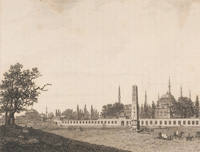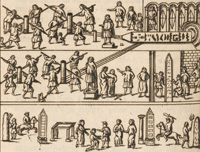
introduction
the profile of the travellers
from a dutch point of view
the power of monuments
idealized landscapes
in search of antiquities
everyday life among ruins
in the service of the divine
athens: a place or an ideal?
ancient vs. contemporary
•
acknowledgements
selected bibliography
catalogue
links and resources travellers
|
|
|
|
|---|
the power of monuments
You gaze on this temple without any ravishing amazement or electrical emotion
Yet on attempting to leave it, you turn round at every step to take another parting look
Rev. Walter Colton on the temple of Hephaestus at Athens (1836)
The power of ruins and ancient remains was well understood in past societies. It was used in various ways by both individuals and social groups to forge identities, establish power and express wealth and social status.
The relocation of ancient structures in the heart of Constantinople, the capital of the Byzantine Empire, is a typical example of the powerful statements that ancient ruins, structures and monuments can make. An ancient Egyptian obelisk (of the 15th century BC) and the so-called 'Greek Serpent column' from Delphi (of the 5th century BC) were, for instance, moved to the Hippodrome of Constantinople in the 4th century AD by the Byzantine Emperors Constantine the Great (c. 280-337) and Theodosius I (347-395).
Both structures became synonymous with the history of the Hippodrome and Constantinople, and added to the wealth and prestige of the Empire's new capital. They acted as permanent reminders of the Empire's domination over its enemies and the power of its rulers.


